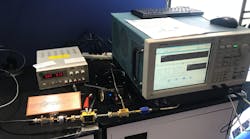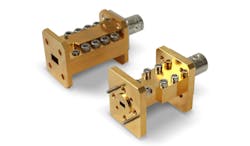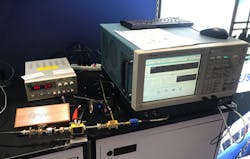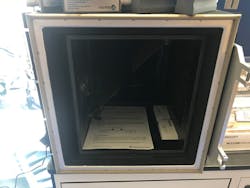At IMS each year, Wireless Telecom Group, comprised of Boonton Electronics, CommAgility, Microlab, and Noisecom, always seems to have several demos on hand for visitors to see. IMS 2019 was no exception, as the company showcased a few different test solutions. One was a millimeter-wave (mmWave) noise figure test arrangement that utilized Noisecom’s new NC5115A additive white Gaussian noise (AWGN) source (Fig. 1). Wireless Telecom Group also demo’d an over-the-air (OTA) test system that featured Noisecom’s NC1128B amplified AWGN source.
1. Noisecom’s new NC5115A AWGN source has a frequency range of 50 to 75 GHz.
The mmWave noise figure solution employed the NC5115A AWGN source, which has a frequency range of 50 to 75 GHz and an excess noise ratio (ENR) of 15.5 dB. This setup was actually a collaboration between Wireless Telecom Group and Tektronix; measurements were made with Tektronix’s RSA5126B real-time signal analyzer (Fig. 2). This analyzer was also used to supply +28 V to the NC5115A AWGN source.
2. The NC5115A AWGN source was at the heart of this mmWave noise figure test setup. Tektronix’s RSA5126B real-time signal analyzer was used to perform measurements.
In the setup, the NC5115A drove the device under test (DUT), which was a V-band low-noise amplifier (LNA). The DUT was followed in order by an isolator, LNA, and bandpass filter. After the filter came a mixer, which was used to downconvert to a frequency within the measurement range of the RSA5126B analyzer. Also included in the setup was a local oscillator (LO) that drove the mixer, with the analyzer supplying the LO with a 10-MHz reference.
To determine the noise figure, the test system was first calibrated without the DUT. The DUT was then placed back into the setup. According to Wireless Telecom Group, measurement uncertainty was reduced thanks to the isolator and the other LNA used in the arrangement. They allowed for a reduction in reflected power between components in the test system by reducing the noise figure of the test setup itself. With this configuration, the company notes that the overall accuracy of the noise-figure measurement is primarily determined by the accuracy of the noise-source calibration.
In addition to the mmWave noise figure test configuration, Wireless Telecom Group also demonstrated an OTA test system (Fig. 3). The company is heavily invested in OTA testing, evidenced by the demonstration of an OTA test system at last year’s IMS. This year’s OTA demo utilized an NC1128B amplified noise module, which has a frequency range of 10 MHz to 10 GHz and can produce AWGN as high as 0 dBm. Wireless Telecom Group asserts that a noise source coupled together with a spectrum analyzer can replace the vector network analyzers (VNAs) used in counterpart test systems.
3. Shown is the enclosure used in the OTA test solution demonstrated at IMS. Inside the enclosure are two Vivaldi antennas—one for transmitting and the other for receiving.
In this setup, the NC1128B was connected to a spectrum analyzer to obtain a normalized reading. After normalizing the spectrum analyzer, the noise source was connected to a transmitting Vivaldi antenna located inside an RF enclosure. The spectrum analyzer was connected to a receiving Vivaldi antenna that was also inside the enclosure. The results obtained allow one to determine path loss and antenna performance for the band of interest. DVTEST provided the enclosure and Vivaldi antennas used in the setup.
Wireless Telecom Group believes that this OTA test system implementation represents a cost-effective approach for production test systems. The company also points out other benefits, stating that “current test methodologies use fast-swept continuous-wave (CW) signals to determine the response of the system. Noise sources transmit an OFDM-like signal with high crest factors and offer broadband performance, which is important since these signals are being received and transmitted in modern communication devices.”
The company also maintains that “production test systems can be subject to repeated connections, which can degrade connector performance. However, noise sources can simply be switched into the setup to determine if the performance has changed without the time-consuming calibration methods associated with VNA-based setups.”




